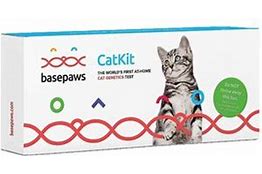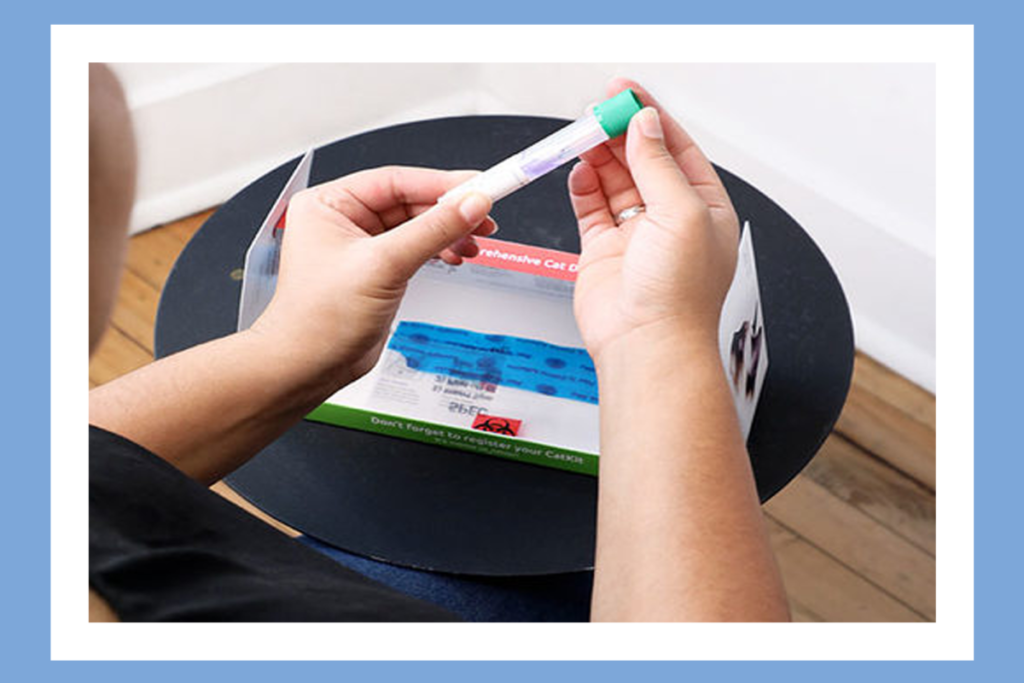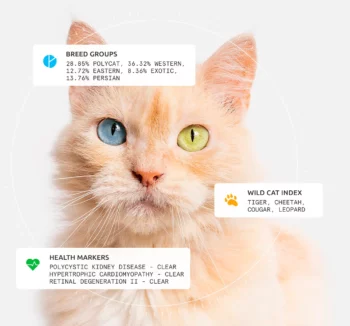Cat DNA tests have become much more sophisticated in modern times. Recent techniques allow researchers to extract and analyze DNA from ancient remains of cats, adding insight into the domestication process.
As previously suspected, cats probably first became domesticated in the Middle East…in fact, some say they domesticated themselves, as they found grain storage silos an excellent spot to find a good meal from some varmint eating up the grain.

Using data from the DNA from 352 ancient cats and 28 modern wildcats, spanning 9,000 years and from regions reaching across Europe, Africa, and Southeast Asia, scientists could pinpoint the domestication process.
Brought into Europe by early farmers some 6,400 years ago, the cats then moved in a second migration, most likely by ship, and colonized Europe and the Middle East about 1,500 years ago.
Besides learning more of the genetic information about sex, development, growth and function of cats, it also becomes possible to learn about a cat’s risk for disease or congenital defects. Thus, the test can give valuable information that might help you avoid potential problems.
What Is A Pet DNA Test?
From a pet DNA test, you will learn essential data about your pet’s ancestry. The typical process includes swabbing your cat’s cheek, sending the swab into the company, and receiving results within a few weeks.

From the data gathered, you will learn extensive family history, details of breed composition, any common health issues, and kitty’s personality traits.
List Of Top 5 Cat DNA Tests, Updated February 2023
From buyersguide.org comes this report listing their selection of the top 5 cat DNA tests
Number 1: WISDOM PANEL, rating 9.9
Breeds screened: 70+ Health Tests: 45+ Results Provided: Breed, health traits, blood type Collection by cheek swab; results in 3 weeks Number 2: BASEPAWS, rating 9.4 Breeds screened: 21 Health Tests: 39+ Results Provided: Breed, health, & oral health Collection by cheek swab; results in 4 to 6 weeks Number 3: 5STRANDS AFFORDABLE TESTING, rating 8.8 Breeds screened: N/A Health Tests: 380 food & environmental intolerances Results Provided: Elimination guide Collection: Fur; results in 7 to 10 days Number 4: ORIVET, rating 8.7 Breeds screened: Must already know cat breed to use Health Tests: 200+ Results Provided: DNA profile & health risks Collection by cheek swab; results in 3 to 6 weeks Number 5: BASEPAWS, rating 8.3 Breeds screened: 21 Health Tests 39+ Results Provided: Breed, dental, health, & raw data Collection by cheek swab; results in 6 to 9 weeks The popularity of pet DNA tests increases, with good reason. Many of our four-legged family members are mixed breeds, and owners want to find out what composes their furry friend's genetic structure. This information can be of great benefit as the information can highlight hereditary conditions, giving potential for prolonging the animal's good health and quality of life.
What Can You Learn From A Cat DNA Test?
Here are some items for which the DNA test can provide information:

Your cat’s lineage: The first cat was the African wildcat, felis silvestris lybica. As the cat population spread around the world, different cats, each with slightly different markers, developed. The sample DNA in a test is compared to 29 cat breeds, and can provide information about how much DNA your cat shares with these breeds.
Coat color and pattern: Over the centuries, mutations have occurred in coat color and pattern, all leading to the varied coat colors and patterns seen in the modern cat.
Coat length: As the gene for long hair is recessive, it means the cat must carry a copy of the gene from each parent for the fur to be long. Sometimes a breeder needs to know if a cat carries a longhaired gene. Enter the DNA test.
Coat type: While shorthair is the default coat type in cats, mutations can occur to change the coat. Included in the coat changes are longhair, hairless, and the rex mutations (Devon Rex and Cornish Rex.)

Diseases: There are over 70 genetic variants and 250 hereditary diseases that can affect cats. A DNA test will identify any inherited diseases, giving the veterinarian and owner a chance to intervene before problems occur.
Here you will find a list of diseases that can be tested for with DNA analysis:
- Polycystic kidney disease
- Hypertropic cardiomyopathy
- Mucopolysaccharidosis
- Progressive retinal atrophy
- Pyruvate kinase deficiency
- Glycogen storage disease
Parentage: The test will verify parentage, which can be useful information for breeders, as they can conform sire and dam of a cat or a litter of kittens.
Blood type: The three blood groups of cats are A, B, and AB. Knowing the blood group is especially important for cat breeders. If a mother cat is type B and the kittens have type A and nurse from that mother during the first 24 hours, it causes a problem. The mother’s first milk, known as colostrum, contains naturally occurring alloantibodies against the kitten’s type A blood group.
What does a test cost? According to one source, the average cost for such a test is from $45.00 to $130.00, depending on brand and type of test.
The Importance Of Learning From A DNA Test
The basic importance of a DNA test stems from the information it provides about kitty. Identify the various genetic markers, mutations, or any genetic disease that could affect your cat in later life.

BREED ANCESTRY helps you know which of the various cat breeds have come together to form your kitty’s background. Something called “breed analysis” sorts out the ancestry of your specific feline. Is your cat purebred or a mixed breed? Is there any wild cat mixed in the composition?
MEDICAL CONDITIONS, as pointed out earlier, become an essential reason for a DNA test. After all, we do want to keep our cats healthy. By determining the different breeds that make up your cat’s genetic background, you can learn what might become a problem due to hereditary makeup.
This health report will also assist you in taking preventive measures against such genetic disease.
POSSIBLE ALLERGIES may be discovered from the test. Kitty’s DNA samples may show certain genetic markers that point toward possible allergies, allowing you to take care of these tendencies before they become problems.
IMPORTANCE OF KNOWING THE BREED stems from the types of problems a certain breed may typically experience. Knowing the problems kitty may encounter allows you to discuss with your vet the best way to either prevent the condition or manage it successfully.

It’s especially vital that breeders know the chromosome map and genetic markers for any of the cats in their care. With such information, they can prevent the risk of inbreeding.
HELPING WITH FUTURE GENERATIONS becomes more possible if you are a breeder. The information gained allows you to understand how much these genetic discases might affect future generations. You can also learn how to prevent these diseases.
Consider The DNA Test A Force For Good
Anything that can give you vital information that could keep your cat in good health has to be a good thing. Yes, you will satisfy your curiosity, but you will also gain knowledge that can lead to an improved overall health plan for your kitty.
References I used for this post: catdnatest.org veterinarians.org/cat-breed-dna-test/ buyersguide.org/dna-tests/t/cat cat-world.com/dna-tests-for-cats/

